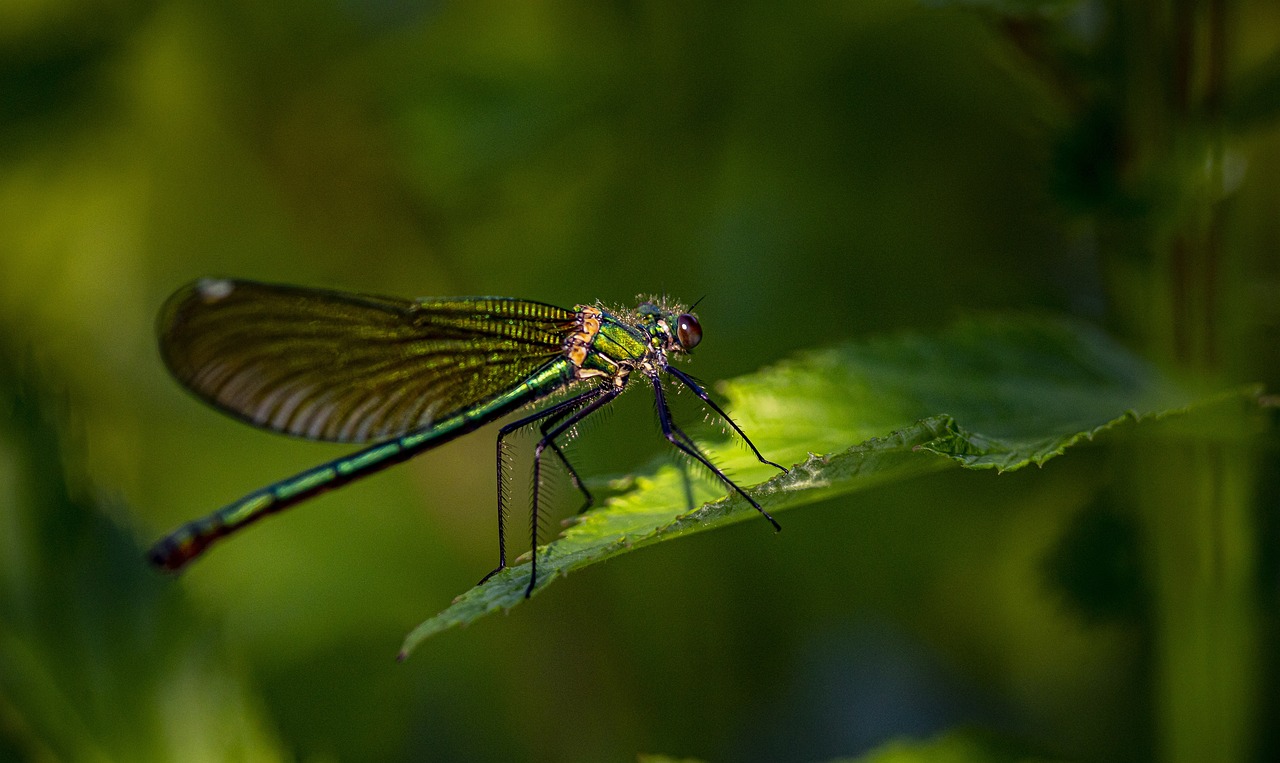The Beautiful Demoiselle (Calopteryx virgo) is a strikingly elegant damselfly belonging to the family Calopterygidae. Known for its shimmering, iridescent wings and graceful flight, it is commonly found near clean, fast-flowing streams and rivers in Europe and parts of Asia.
Physical Description
- Size:
- Body length: 45–49 mm
- Wingspan: 60–70 mm
- Males:
- Metallic blue or green bodies with a distinctive dark blue-black sheen on the wings.
- Females:
- Metallic green or bronze bodies with translucent, green-tinted wings.
- Distinctive Feature:
- Both sexes have broad, rounded wings, contributing to their graceful flight and easy identification.
Behavior
- Flight Period:
- Active from late spring to late summer (May to August).
- Flight Style:
- Slow and fluttering, resembling butterflies.
- Territoriality:
- Males are territorial, defending stretches of streams or rivers to attract females.
- Mating Display:
- Males perform intricate flight displays, showing off their iridescent wings to impress females.
Habitat
- Prefers clean, fast-flowing streams and rivers with well-vegetated banks.
- Common in wooded areas, where shaded water bodies provide optimal conditions for breeding and hunting.
Diet
- Adults:
- Feed on small flying insects such as midges, gnats, and mosquitoes.
- Larvae:
- Aquatic and predatory, feeding on small invertebrates in the water.
Life Cycle
- Eggs:
- Females lay eggs on submerged vegetation or debris in flowing water.
- Larvae:
- Aquatic stage lasts 1–2 years, during which the larvae molt several times.
- Prefers oxygen-rich water with minimal pollution.
- Adults:
- Emerge in late spring or early summer.
- Adults live for a few weeks, focusing on reproduction and feeding.
Distribution
- Found across much of Europe, extending into Asia Minor and parts of western Asia.
- Absent from very cold or arid regions.
Conservation Status
- Least Concern, but sensitive to water quality and habitat disturbance.
- Threats include pollution, habitat destruction, and changes to river flow due to damming or irrigation.
Ecological Role
- Predator: Helps control populations of small flying insects.
- Indicator Species: Its presence indicates healthy, clean freshwater ecosystems.
Interesting Facts
- Wing Shimmer: The metallic hues of its wings result from structural coloration rather than pigments.
- Behavioral Rivalry: Males engage in aerial “dogfights” to defend their territories.
- Wide Habitat Preference: Although they prefer clear streams, they can tolerate slightly shaded and slower-flowing waters compared to the similar Banded Demoiselle (Calopteryx splendens).
Summary
The Beautiful Demoiselle (Calopteryx virgo) is a jewel of Europe’s freshwater habitats. Its vivid colors, graceful movements, and role as a bioindicator make it a cherished species among nature enthusiasts and conservationists alike. Protecting its habitats ensures the survival of not only this exquisite damselfly but also the ecosystems it represents.
Visited 818 times, 3 visit(s) today
Views: 1121
Subscribe to the newsletter:
